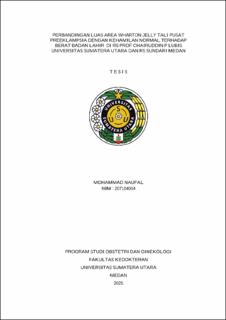| dc.description.abstract | Background: Preeclampsia is a hypertensive disorder of pregnancy that remains a leading cause of maternal and perinatal morbidity, often resulting in fetal growth restriction. The umbilical cord, composed of two arteries and one vein encased in Wharton’s jelly (WJ), plays a vital role in maintaining fetal circulation. WJ is a gelatinous connective tissue that protects umbilical vessels and contributes to vascular resilience. Reduced WJ area has been associated with adverse pregnancy outcomes, including low birth weight..
Methods :A cross-sectional analytical study was conducted Universitas Sumatera Utara Hospital and Sundari Hospital from February to May 2025. Fourty term pregnancies (37–40 weeks) were included and divided equally into preeclampsia (n=20) and normotensive (n=20) groups. Umbilical cord tissue was collected post-delivery, processed using hematoxylin-eosin and Periodic Acid Schiff staining. The Wharton Jelly area was calculated from umbilical cord area substracts with 2 arteries area and 1 umbilical vein area
Results: Wharton’s Jelly area was significantly smaller in the preeclampsia group (52.37 ± 10.12 mm²) compared to the normotensive group (67.42 mm² (56.47-103.52); p<0.001). A significant positive correlation between Wharton’s Jelly area and birth weight was found in the normotensive group (r=0.446, p=0.049), but not in the preeclampsia group (r=-0.168, p=0.478)
Conclusion: These findings suggest that a reduced WJ area is associated with lower birth weight in normal pregnancies, whereas in preeclampsia, additional factors may impair fetal growth despite WJ morphology. This study highlights the importance of WJ assessment as a potential marker of fetal well-being, particularly in normotensive pregnancies, and underscores the need for further research in preeclampsia.
Keywords: Birth Weight, Fetal Growth, Preeclampsia, Wharton’s Jelly, Umbilical Cord, Umbilical artery, Umbilical vein | en_US |


